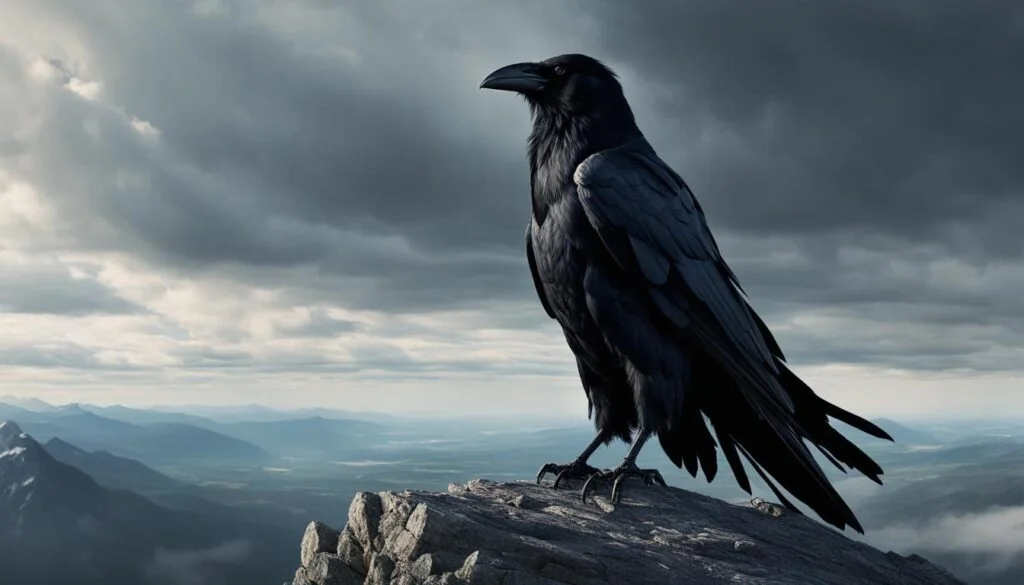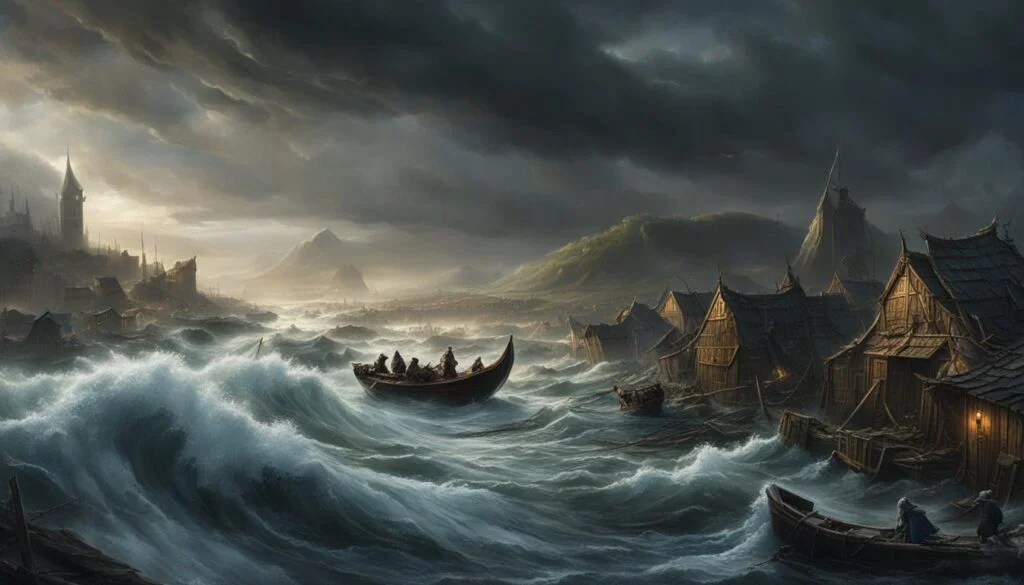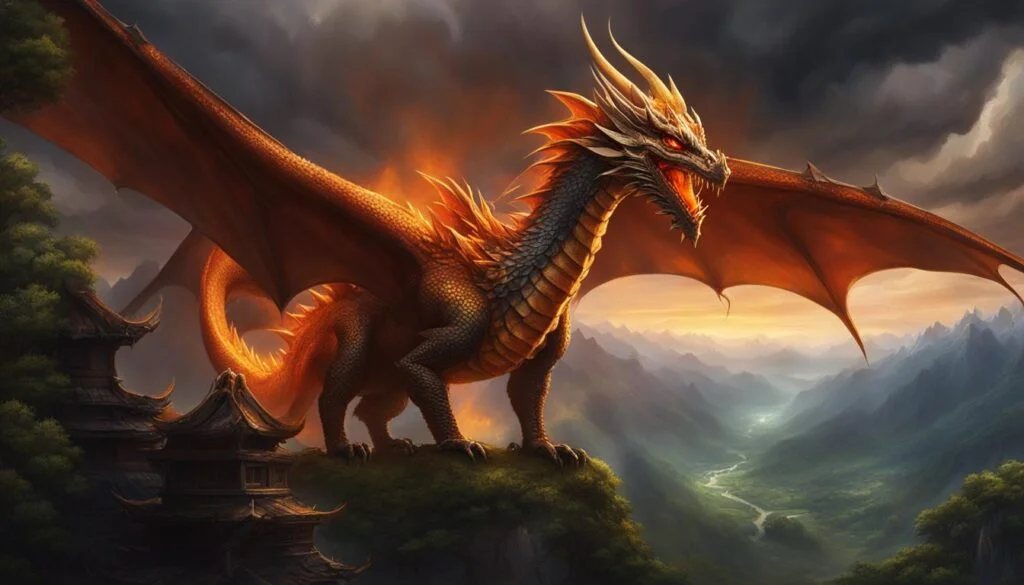Welcome to the captivating world of Norse mythology, where gods and legends intertwine.
In the realm of Norse gods, none stands taller than Odin, the chief god and a figure of great power and wisdom.
Odin, the chief god in Norse mythology, is revered for his wisdom, knowledge, and leadership. He is also known for his extraordinary powers, including control over storms, shape-shifting abilities, and the ability to see all that happens in the world.
Let us delve into Odin’s story, uncovering his role in Norse mythology, his extraordinary powers and abilities, his intriguing family connections, and the enduring significance of his legacy.
Key Takeaways:
- Odin is the chief god in Norse mythology, revered for his wisdom, knowledge, and leadership.
- He possesses extraordinary powers, including control over storms, shape-shifting abilities, and the ability to see all that happens in the world.
- Odin’s family connections are intricate and include his wife, the goddess Frigg, and his sons, including the mighty Thor.
- His quest for wisdom and knowledge drives him to make sacrifices and seek mystical experiences.
- Odin’s influence extends beyond ancient mythology, shaping cultural expressions, religious practices, and scholarly studies today.
Odin’s Origins and Names
Odin, also known as Óðinn, has a rich history and is associated with various epithets and names in Norse mythology.
Odin’s name derives from Old Norse and is cognate with other medieval Germanic names like Old English Wōden and Old High German Wuotan.
The Proto-Germanic theonym *Wōðanaz, from which his name originates, refers to his role as the “lord of frenzy” or the “leader of the possessed”.
Throughout Norse mythology, Odin is recognized by a multitude of names and epithets that reflect his diverse attributes and roles.
Odin’s Epithets
Odin is often referred to as the “Allfather,” signifying his role as the chief of the gods in Norse mythology.
Another epithet associated with Odin is “One-eyed,” which reflects his sacrifice of an eye in exchange for knowledge and wisdom.
Odin is also known as the “Wanderer,” embodying his frequent journeys and explorations.
Etymology and Meaning
The etymology of Odin’s name and titles provides insights into his associations and significance in Norse mythology.
In addition to frenzy and possession, Odin’s name is connected to concepts of inspiration and poetic wisdom, aligning with his roles as the god of poetry and an authority on runes.
Names for Odin in Norse Mythology
- Óðinn – Odin
- Wōden – Woden
- Wuotan – Wuotan
These are just a few examples of the many names used to refer to Odin in Norse mythology.
Odin’s origins and names offer valuable insights into the complex nature of this revered Norse deity.
By examining the etymology and various epithets associated with Odin, we gain a deeper understanding of his role and significance in Norse mythology.
Odin’s Role in Norse Mythology
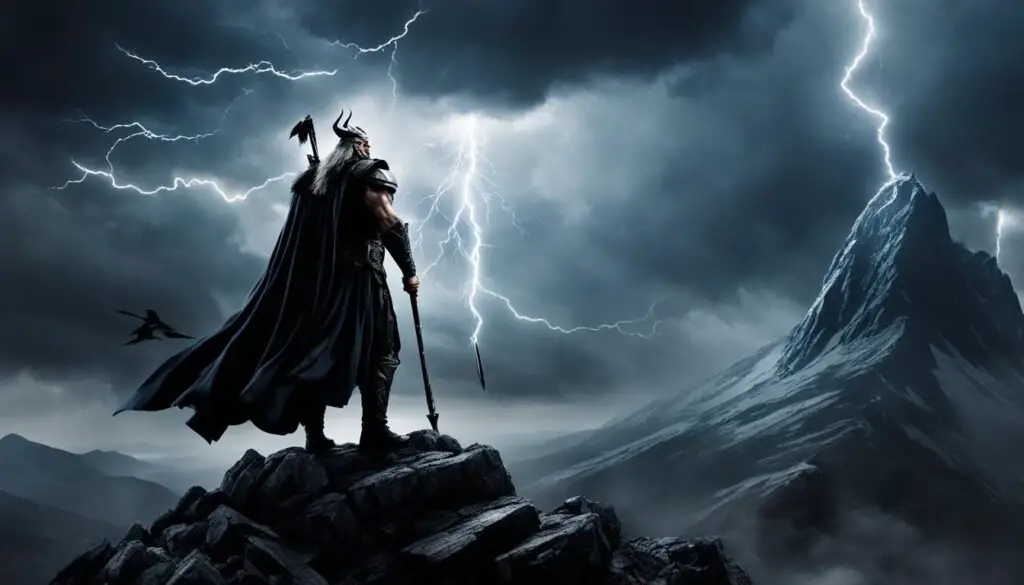
Odin, the ruler of the gods in Norse mythology, holds a prominent and significant role in the ancient tales.
His influence spans across various aspects of the mythology, including creation, holidays, afterlife, and the ultimate battle of Ragnarök.
According to Norse mythology, Odin played a key role in the creation of the world. He slayed the primordial giant Ymir and used Ymir’s body to form the Earth.
Odin’s power and wisdom also gave life to the first humans, Ask and Embla.
Yule, a prominent holiday in Norse mythology, is associated with Odin. As the ruler of the gods, Odin oversees the festivities of Yule, a celebration of the winter solstice and the rebirth of the sun.
Yule holds great importance in the Norse calendar and is marked by feasting, gift-giving, and bonfires.
Valhalla, a majestic hall in Asgard, is another aspect of Odin’s role in Norse mythology. It is believed to be a place where warriors who die in battle go after death.
Odin carefully selects half of these fallen warriors, aided by the valkyries, divine maidens who choose the bravest warriors to reside in Valhalla.
Furthermore, Odin’s role extends to the prophecies of Ragnarök, the final battle of the gods.
He consults with the wise Mímir, whose well contains secret knowledge, to gain insight into the impending doom foretold by the prophecies.
As the ruler of the gods, Odin’s actions and decisions have a profound impact on the outcome of Ragnarök.
The valkyries, under Odin’s influence, play a crucial role in Norse mythology as well. These divine beings serve as Odin’s messengers and warriors.
They choose fallen warriors to join Odin in Valhalla, while also ensuring the warriors’ heroic deaths on the battlefield.
Odin’s role in Norse mythology encompasses his position as the ruler of the gods, his involvement in creation and holidays, his connection with Valhalla and the valkyries, and his influence on the events leading up to Ragnarök.
These aspects highlight Odin’s significance in the pantheon of Norse gods and goddesses.
Odin’s Powers and Abilities
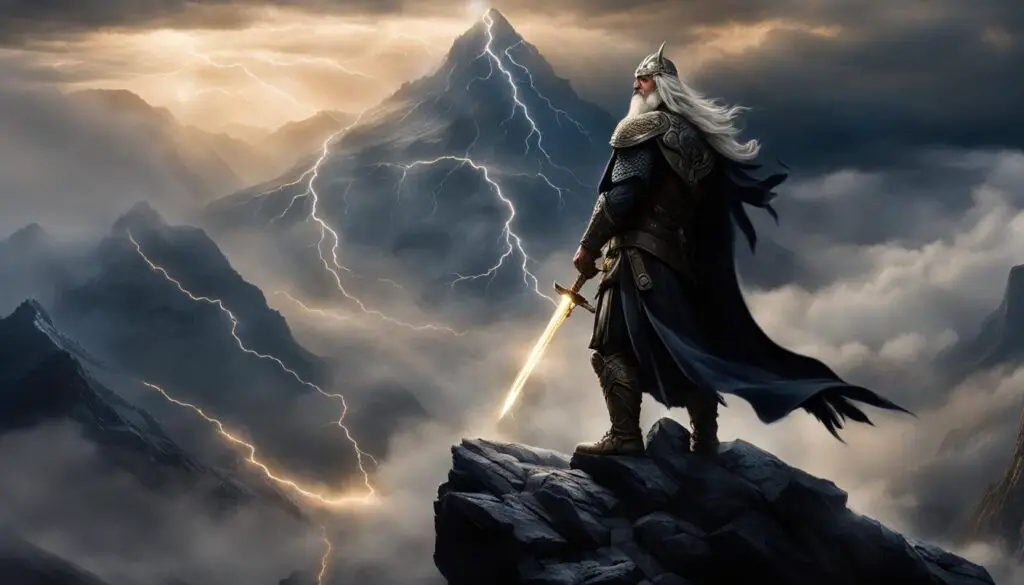
Odin, the chief god in Norse mythology, possesses a myriad of extraordinary powers and abilities that elevate him above other gods and beings in the pantheon.
One of Odin’s most notable powers is his mastery of magic. Through his deep understanding of the arcane arts, he can manipulate and shape the forces of nature to his will.
One of the most awe-inspiring displays of this power is Odin’s ability to control storms. With a mere wave of his hand, he can unleash mighty tempests and command the very elements themselves.
Furthermore, Odin has unparalleled knowledge of runes, an ancient writing system believed to hold great mystical power.
He imparts this knowledge to humanity, unlocking the secrets and hidden meanings contained within these ancient symbols.
Odin’s shape-shifting abilities are also legendary. He can effortlessly assume the form of animals or other beings, seamlessly blending into his surroundings and assuming various roles as he pleases.
In addition, Odin possesses the remarkable power to see everything that transpires in the world.
Through sacrificing one of his own eyes to the mysterious well of Mímir, he gained the ability to perceive events and gain insights beyond the scope of ordinary mortals.
Another facet of Odin’s abilities lies in his power to calm storms and dangerous forces. With a mere whisper, he can bring tranquility to turbulent seas and pacify the most tempestuous of elements.
It is clear that Odin’s powers and abilities make him a formidable force in Norse mythology.
His command over storms, knowledge of runes, shape-shifting prowess, all-seeing sight, and power to calm storms showcase the breadth of his mystical capabilities and his central role as a divine force in the ancient Scandinavian world.
Five Facts About Odin:
- ✅ Odin possesses vast magical abilities, allowing him to control storms and manipulate the forces of nature.
- ✅ He holds unparalleled knowledge of runes, imparting wisdom and unlocking the hidden meanings contained within these ancient symbols.
- ✅ Odin is a skilled shape-shifter, capable of assuming various forms and seamlessly blending into different surroundings.
- ✅ Through sacrificing one of his eyes, he gained the ability to see everything that happens in the world, transcending the limitations of mortals.
- ✅ Furthermore, Odin has the remarkable power to calm storms and dangerous forces, bringing tranquility to the most chaotic of situations.
Odin’s Relationships and Family
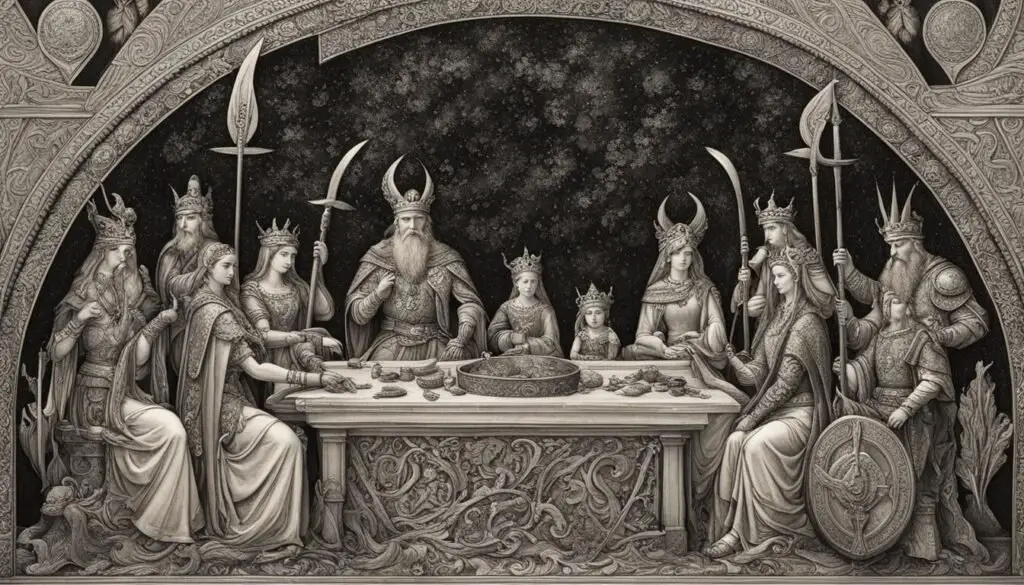
In Norse mythology, Odin has a rich and intricate web of relationships and family members that add depth to his character and highlight his place in the divine family tree.
Let’s explore Odin’s relationships and the members of his family.
Marriage to Frigg and Their Sons
- Odin is married to the goddess Frigg, who holds a significant position in Norse mythology. They are regarded as the divine couple, representing the union of wisdom and sovereignty.
. - Together, Odin and Frigg have two notable sons. The first is Thor, the powerful god of thunder and one of the most prominent figures in Norse mythology. The second is Baldr, often associated with beauty, innocence, and light.
Other Children of Odin
- Beyond Thor and Baldr, Odin has fathered numerous other children through various relationships.
. - Some of his other sons include Vali, Vidar, and Heimdallr. These individuals possess exceptional abilities and play significant roles in Norse mythology.
Odin’s Relationships Beyond His Marriage
- Odin is known to have relationships with other beings in Norse mythology. Two notable examples are his relationships with the giantess Gunnlod and the jötunn (giantess) Rindr.
Bonds with Other Gods and Goddesses
- In addition to his family members, Odin forms close bonds with other gods and goddesses in the Norse pantheon.
. - One such important relationship is with Loki, the trickster god, with whom Odin shares a complex and intricate dynamic.
. - Odin also shares a close connection with Freyja, the goddess associated with love, beauty, and fertility.
The relationships and family connections of Odin create a rich tapestry of intricate dynamics within the Norse mythology pantheon.
These interconnected relationships contribute to the complexity of Odin’s character and his role in the divine family tree.
Odin’s Animals and Companions
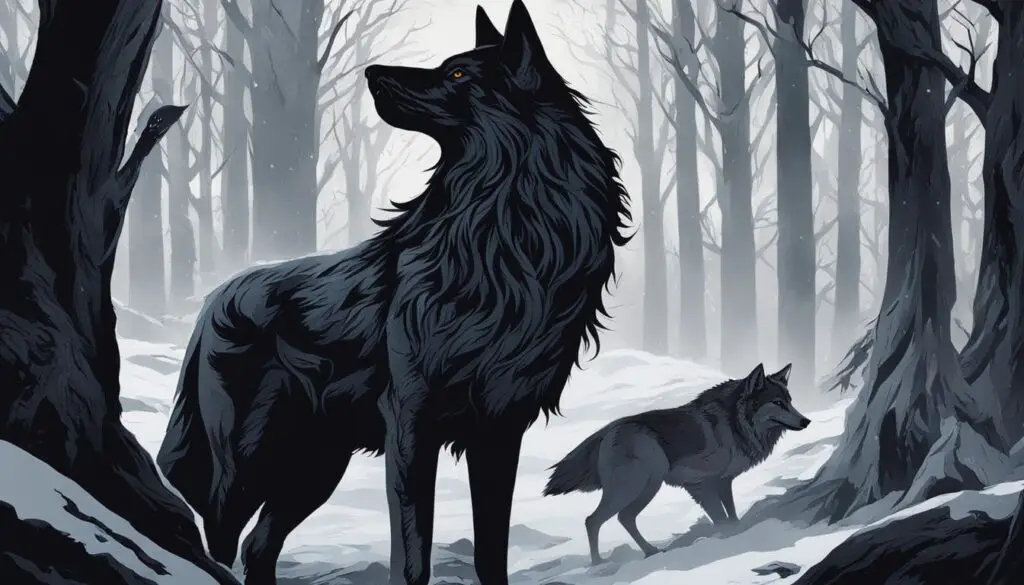
In Norse mythology, Odin is often depicted with his faithful animal companions and familiars that accompany him on his journeys and adventures.
These animals play an integral role in Odin’s mythology and symbolize different aspects of his power, knowledge, and connection to the supernatural.
At Odin’s side are his two trusted ravens, Huginn and Muninn, whose names translate to “Thought” and “Memory” respectively.
These intelligent birds fly across the world, gathering information and bringing it back to Odin. They serve as his eyes and ears, providing him with valuable insight and wisdom.
In addition to his ravens, Odin has two loyal companions in the form of wolves. Geri and Freki are their names, symbolizing “Greed” and “Ferocity.”
These fierce predators represent Odin’s relentless pursuit of power and his ability to unleash destructive forces when necessary.
Another significant animal associated with Odin is his majestic horse, Sleipnir. This extraordinary steed possesses eight legs and is heralded as the fastest and most agile in all the realms.
Sleipnir acts as Odin’s trusted mount, carrying him between worlds and allowing him to traverse great distances in his quest for knowledge and adventure.
The animals that accompany Odin in Norse mythology are not mere companions but embody important aspects of his character and abilities.
They are symbols of his connection to the natural world, his mastery over the supernatural, and his insatiable thirst for wisdom and power.
Odin’s Quest for Wisdom and Knowledge
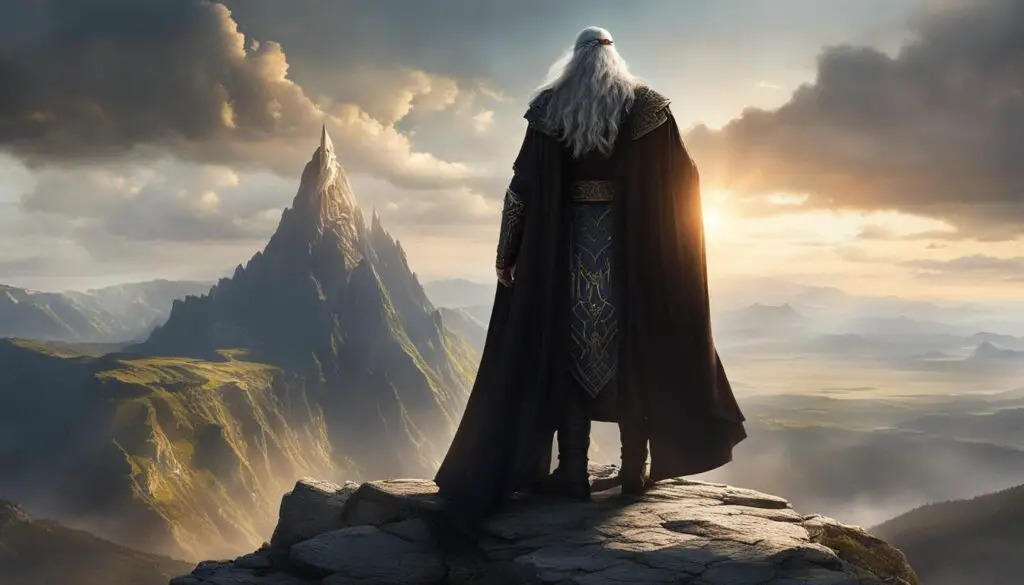
One of the most fascinating aspects of Odin’s mythology is his unwavering pursuit of wisdom and knowledge.
The chief god of Norse mythology goes to great lengths and sacrifices to gain a deeper understanding of the world and its mysteries.
Odin’s quest for wisdom is exemplified in his encounters with Mímir, a wise being associated with knowledge and secrets.
In order to gain access to Mímir’s well, which holds sacred knowledge and visions, Odin sacrifices his own eye.
This willingness to give up part of himself demonstrates the extent of his commitment to acquiring wisdom.
Additionally, Odin embarks on a profound journey of self-sacrifice and enlightenment by hanging himself on Yggdrasil, the world tree, for nine days and nights.
This act grants him profound wisdom of the other realms and the ability to interpret the mystical runes, ancient symbols of power and knowledge.
By willingly sacrificing his own eye and enduring the physical and spiritual hardships of hanging from the world tree, Odin showcases his unparalleled dedication to acquiring knowledge.
His quest for wisdom serves as a testament to his role as the chief god of Norse mythology and his insatiable hunger for understanding.
The Importance of Wisdom in Norse Mythology
In Norse mythology, wisdom is highly valued and associated with divine power and insight.
Odin’s pursuit of wisdom aligns with the deeper themes of the Norse pantheon, highlighting the significance of knowledge and its impact on the actions and destinies of both gods and mortals.
- Wisdom allows Odin to navigate the complexities of the world and make informed decisions that shape the course of events in Norse mythology.
. - By seeking wisdom, Odin gains a deeper understanding of the universe and the intricacies of fate, enabling him to make prophecies about the future, including the impending doom of Ragnarök.
. - Odin’s sacrifices for wisdom symbolize the inherent value placed on learning and the lengths an individual is willing to go to unlock the secrets of existence.
Odin’s quest for wisdom and knowledge offers a profound insight into the intricate layers of Norse mythology and the profound connection between wisdom and power within this ancient belief system.
Odin’s Association with Stories and Poetry
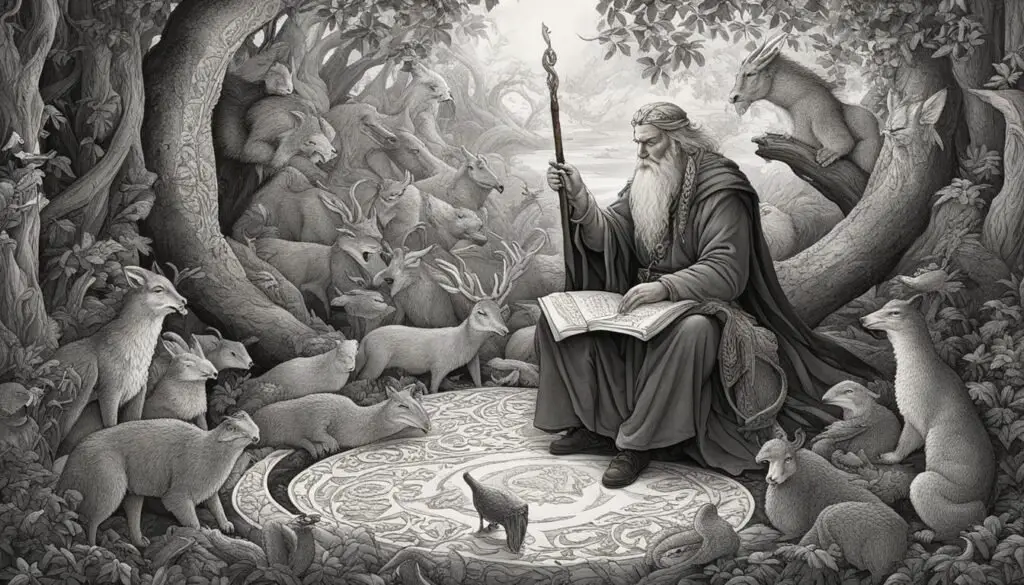
Odin, the chief god in Norse mythology, has a profound connection to stories and poetry.
He is revered as a master storyteller, renowned for his poetic inspiration and patronage of skaldic poetry.
Odin’s love for storytelling is evident in the many tales that surround him in Norse mythology.
He is often depicted sharing stories and mead with his fellow gods and goddesses, particularly with Sága, the goddess of history and storytelling.
Recognizing the power of language and narratives, Odin values the preservation of tales and the wisdom they hold.
Through stories, he imparts knowledge and conveys important life lessons.
Odin’s association with poetry is also significant. Skaldic poetry, characterized by complex metaphors and kennings, holds a special place in Norse culture, and Odin is considered the ultimate source of poetic inspiration.
In Norse mythology, skalds are the poets and bards who compose and recite epic poems.
They are responsible for transmitting collective knowledge, traditions, and the rich tapestry of Norse myths.
Odin’s connection to skaldic poetry underscores his role as a catalyst for creativity and the preservation of cultural heritage.
The Legacy and Influence of Odin
Odin’s legacy and influence extend far beyond ancient Norse mythology. His character continues to captivate scholars in the field of Germanic studies, who delve into his historical development and connections with other deities and figures.
The enigmatic nature of Odin has also sparked the imaginations of poets, musicians, and artists throughout history, inspiring a myriad of creative works.
Moreover, Odin remains a significant figure in Heathenry, a modern religious movement that honors the gods and traditions of the Germanic people.
Additionally, his influence permeates popular culture, with references to Odin appearing in literature, movies, and various forms of media, ensuring his enduring presence in contemporary society.
Conclusion
Odin, the chief god in Norse mythology, is a complex and multifaceted deity who holds great significance in the Norse pantheon.
His story encompasses a rich tapestry of origins, powers, relationships, and quests that highlight his role as a symbol of wisdom, knowledge, and poetic inspiration.
Key takeaways from Odin’s mythology include his association with wisdom and knowledge-seeking.
Through sacrifices and rituals, Odin demonstrates his relentless pursuit of understanding the mysteries of the universe.
His sacrifice of an eye and hanging from the world tree Yggdrasil for nine days and nights serve as powerful symbols of his commitment to gaining insight and prophetic wisdom.
By delving into Odin’s story, we gain a deeper understanding of the intricate dynamics within Norse mythology.
From his leadership as the ruler of the gods to his role in the creation of the world and his association with Valhalla and the valkyries,
Odin shapes the very fabric of this mythological universe.
Odin’s continued influence can be seen in various areas of culture and academia. From ongoing studies in Germanic studies to his portrayal in art, literature, and popular culture, Odin’s legacy remains alive and continues to inspire and captivate audiences today.
Frequently Asked Questions
Q: What was Odin the god of?
A: Odin was the Norse god of war, wisdom, poetry, death, divination, and magic. He was the chief of the Aesir and ruler of Asgard, known for his quest for knowledge and sacrifice for wisdom.
Q: Who is Odin to Zeus?
A: Odin and Zeus are similar in that they are both the chief gods in their respective mythologies (Norse and Greek), ruling over the gods and humans. However, they are from different pantheons and do not have a direct relationship.
Q: What is Odin’s power?
A: Odin’s powers include immense wisdom, foresight, and understanding of the runes, which provide him with knowledge of magic and prophecy. He also has the ability to shape-shift, speak with the dead, and wield his spear, Gungnir, which never misses its target.
Q: Is Loki the son of Odin?
A: In Norse mythology, Loki is not the biological son of Odin but is often referred to as his son because of their close association. Loki is actually a Jotun (giant) by birth, but he became Odin’s blood brother, thus making him part of the Aesir family.
Q: Why did Odin take Loki as a baby?
A: The myths vary, but most do not depict Odin taking Loki as a baby. Instead, Loki is described as Odin’s blood brother or companion, indicating a bond formed later in life rather than Loki being adopted as a child by Odin.
Q: Did Odin love Loki?
A: Norse myths suggest a complex relationship between Odin and Loki, characterized by both camaraderie and conflict. While “love” might not be explicitly stated, Odin valued Loki for his cunning and often relied on him for difficult tasks, indicating a form of kinship and affection.
Q: Why does Odin make Loki his blood brother?
A: The exact reasons vary by source, but making Loki his blood brother was likely a strategic move by Odin, recognizing Loki’s intelligence and abilities as valuable assets to the Aesir, despite Loki’s trickster nature.
Q: Is Tyr son of Odin?
A: In some Norse texts, Tyr is considered the son of Odin, while other sources name him as the son of the giant Hymir. Tyr is the god of war, justice, and law, known for his bravery and the sacrifice of his hand to the wolf Fenrir.


